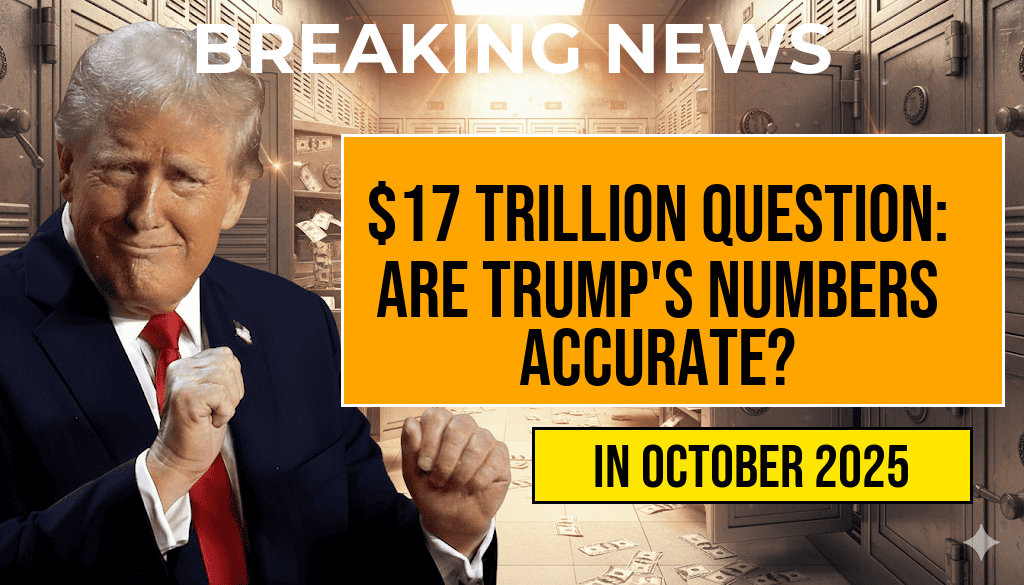Amid ongoing debates over the accuracy of former President Donald Trump’s publicly stated global investment figures, economists and financial analysts are scrutinizing the credibility of claims surrounding the scale and scope of his international financial holdings. Trump has frequently asserted that his investments amount to over $17 trillion worldwide, positioning himself as a global business magnate with extensive interests spanning continents. However, independent experts and financial watchdogs question whether these figures are inflated, misrepresented, or reflective of complex ownership structures that obscure actual asset values. As policymakers and investors alike seek clarity on Trump’s financial stature, the controversy underscores broader issues about transparency and accountability in the realm of high-net-worth individuals’ disclosures.
Dissecting the $17 Trillion Claim
Trump’s assertion of possessing investments exceeding $17 trillion has been a central theme in his public statements, especially during his presidential campaigns. The figure reportedly encompasses a wide array of assets, including real estate holdings, business interests, stock portfolios, and international assets. According to Trump’s own disclosures and statements, these holdings span over 20 countries, with significant investments in sectors such as real estate development, branding, and licensing agreements.
Nevertheless, critics question the methodology behind these numbers. Financial experts point out that estimating the total value of global assets, especially when they involve private holdings, joint ventures, and complex ownership structures, is inherently challenging. Some analysts suggest that the figure may include projected or inflated valuations designed to bolster Trump’s image as a global powerhouse. Others argue that the number might be a compilation of assets held through various corporations and LLCs, making it difficult to verify the actual net worth or investment size.
Sources of the Dispute
- Transparency of Asset Valuations: Many of Trump’s holdings are privately held, with limited independent valuation data. This opacity fuels suspicion about the accuracy of reported figures.
- Ownership Structures: Complex corporate arrangements, including offshore entities and subsidiaries, can obscure the true scale of assets, complicating efforts to verify claims.
- Differing Definitions of “Investment”: Some analysts argue that Trump’s figures may include projected revenues or potential future earnings, rather than current net asset values.
Expert Perspectives and Analyses
Financial Analysts and Economists
Several industry experts have cast doubt on the legitimacy of the $17 trillion figure. Dr. Laura Simmons, a senior economist at the Economic Policy Institute, notes, “While Trump undoubtedly has extensive holdings, aggregating these into a single figure of that magnitude without detailed disclosures is problematic. The lack of transparency makes it difficult to assess whether these numbers represent actual assets or aspirational estimates.”
Similarly, Forbes’ investigative team has pointed out that publicly available data on Trump’s real estate and business interests, while extensive, do not support a total valuation anywhere near the claimed amount. They emphasize that many of his holdings are valued based on market estimates or contractual agreements, which can fluctuate significantly over time.
Legal and Regulatory Considerations
Legal experts highlight that public figures, especially those with significant business interests, are often subject to disclosure requirements that vary by jurisdiction. The accuracy of such disclosures depends heavily on the transparency of the underlying assets and the willingness of individuals to provide complete information. In Trump’s case, some argue that the complex web of entities and offshore accounts makes full transparency difficult, raising questions about the veracity of his reported figures.
The Broader Context: Transparency and Public Perception
The debate about the credibility of Trump’s investment figures taps into larger issues of transparency in the political and financial spheres. Accurate asset disclosure is critical for assessing potential conflicts of interest and ensuring accountability. Critics argue that inflated or opaque figures undermine trust, while supporters assert that such claims are part of a broader effort to project strength and economic prowess.
Implications for Investors and Policymakers
| Aspect | Potential Impact |
|---|---|
| Investor Confidence | Uncertainty regarding asset valuations could influence investor decisions and market stability. |
| Policy Formulation | Legislators may face challenges in crafting policies related to financial transparency and corporate governance. |
| Public Trust | The credibility of political figures with significant economic interests hinges on transparent disclosures. |
The Ongoing Debate
As discussions continue, some analysts advocate for more stringent disclosure standards, emphasizing the importance of verified, transparent reporting in fostering trust. Others caution against jumping to conclusions without access to comprehensive financial data. The controversy underscores the broader challenge of assessing the true scale of individual wealth in an era of complex, multi-layered financial arrangements.
For now, the question remains open: How accurate are the global investment figures attributed to Donald Trump, and what do they reveal about the intersection of wealth, transparency, and political influence? As investigative efforts and public scrutiny intensify, clarity may emerge—though the debate highlights enduring issues about the visibility of private wealth in the public eye.
Sources such as Wikipedia’s page on Donald Trump and Forbes provide additional context on Trump’s financial history and holdings, but definitive verification of the $17 trillion figure remains elusive.
Frequently Asked Questions
What is the main focus of the article titled “The $17 Trillion Question”?
The article examines the debate among economists regarding the accuracy of Trump’s global investment figures, specifically questioning the validity of the claimed $17 trillion total.
Why are economists questioning the validity of Trump’s global investment figures?
Economists are scrutinizing the methodology and data sources used to calculate the $17 trillion figure, raising concerns about potential overestimations and misrepresentations of Trump’s actual investments.
What are the implications of inaccuracies in Trump’s global investment figures?
Inaccurate figures could impact public perception, influence policy decisions, and affect economic analyses related to Trump’s financial influence on a global scale.
How do economists differ in their opinions about Trump’s investment data?
Some economists believe the figures are inflated or misleading, while others argue that, despite potential discrepancies, the overall investment impact remains significant and worth considering.
What might be the next steps for verifying the accuracy of Trump’s global investment figures?
Further investigations, audits, and transparency efforts are needed to verify the exact scope of Trump’s investments and to establish a more reliable estimate.






